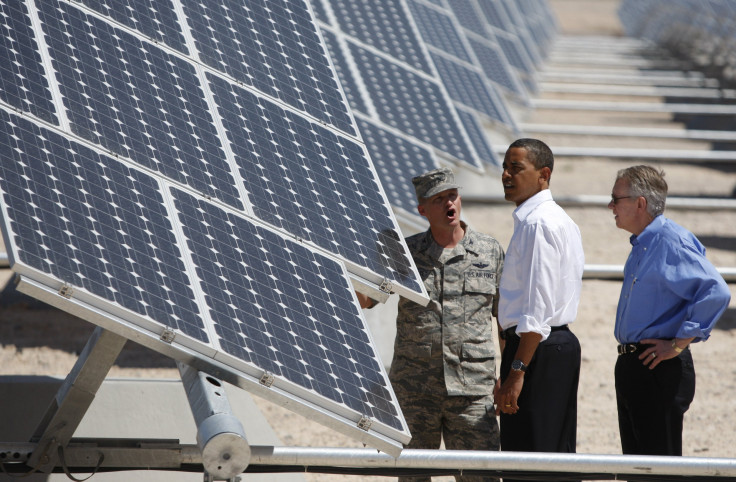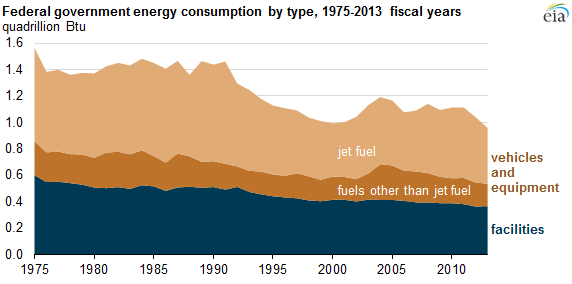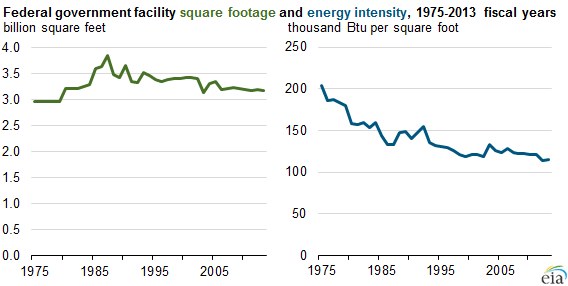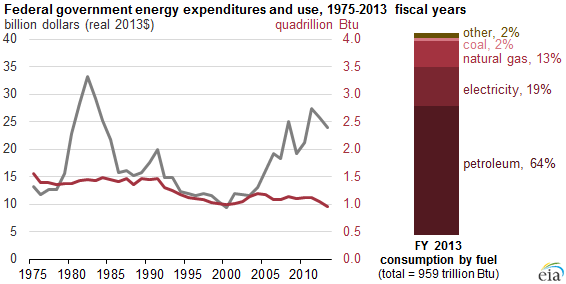Federal Energy Use Drops To Lowest Level On Record, Thanks To Major Energy-Efficiency Push

Energy use in federal post offices, court houses and military bases has dropped to its lowest level on record. The sharp decline is largely thanks to a Bush-era push to slash electricity and fuel consumption in thousands of facilities and vehicles, energy analysts say.
Total delivered-to-site energy use by the federal government fell to 0.96 quadrillion British thermal units (Btu) in fiscal 2013, the lowest amount since record keeping began in 1975, the U.S. Energy Information Administration (EIA), the Department of Energy’s statistics arm, reported Wednesday. Roughly half that total came from jet fuel, while the rest came from other liquid fuels and electricity in buildings.

One reason for declining energy use in recent decades is the government’s shrinking footprint, both in the U.S. and abroad. Total square footage occupied by the federal government has dropped continually since its peak in 1987, about the time the U.S.' Cold War with Soviet Russia began to wind down and the Department of Defense began shuttering facilities, Rebecca George, an EIA research analyst, said.
In recent years, however, “a lot of the decline was due to a reduction in energy intensity -- the energy consumption per square foot,” George said. She noted that in 2013, the government’s energy intensity dropped 21 percent compared with 2003 levels.
The federal government occupies around 500,000 buildings and operates more than 600,000 vehicles, making it the largest energy-consuming entity in the country, according to the White House.
Many federal agencies are required to curb their energy intensity by 3 percent each year, with the goal of slashing intensity by a total of 30 percent in fiscal 2015. Congress passed the rule as part of the 2007 Energy Independence and Security Act, a sweeping law that also pushes investments in renewable energy and energy-efficient technologies.
“A lot of buildings in the federal government are trying to reach that goal. It’s pretty ambitious,” George said.

President Barack Obama has also called for reducing federal energy use. In 2009, he signed an executive order requiring federal agencies to set a 2020 target for curbing greenhouse gas emissions. Under Obama’s 2013 Climate Action Plan, agencies must also aim to get 20 percent of their electricity from renewable sources by 2020. “Our federal government has to lead by example,” Obama said in a speech announcing the plan.
Despite the decline in federal energy use, the government’s bills are still rising. Total energy costs reached $24 billion in 2013, up from a record low of $9.4 billion in 2000. “Our energy costs are heavily based on crude oil prices,” George explained.
In recent years, global oil prices topped $100 a barrel, increasing the costs of jet and motor fuels that power federal planes, tanks and cars. Over the past six months, however, oil prices have declined by more than 50 percent, to around $50 a barrel, which will likely provide some relief for the federal government. “I imagine that energy costs for fiscal 2014 and 2015 could possibly be lower on a per-Btu basis,” George said.

© Copyright IBTimes 2024. All rights reserved.




















